No CrossRef data available.
Article contents
Stephen Crane: Classic at the Crossroads
Published online by Cambridge University Press: 17 February 2011
Extract
Vain, pushing, pretentious and unquestionably naive, Stephen Crane emerges from the collected letters as something less than one's idea of a literary genius. As Professor Stallman says in his introduction, the letters do give us “a new perspective” on Crane. Artists are notoriously self-contradictory, Professor Stallman tells us; but there is something disturbing about the contradictoriness of these letters, where Crane says one thing to one friend and something very different to another, makes high claims for himself in one letter and low ones in the next. The letters, indeed, tempt the reader to make an overall hypothesis about them; they may have the variousness of the complicated mind that makes an interesting personality (Stallman's reading of the case) or they may be the letters of a man whose largest aim in life was to dramatize himself and to impress others. He says in one letter (to John Northern Hilliard):
The one thing that deeply pleases me in my literary life – brief and inglorious as it is – is the fact that men of sense believe me to be sincere…Personally I am aware that my work does not amount to a string of dried beans – I always calmly admit it…I go ahead, for I understand that a man is born into the world with his own pair of eyes, and he is not at all responsible for his vision – he is merely responsible for his quality of personal honesty. To keep close to this personal honesty is my supreme ambition. There is a sublime egotism in talking of honesty. I, however, do not say that I am honest. I merely say that I am as nearly honest as a weak mental machinery will allow. This aim in life struck me as being the only thing worth while. A man is sure to fail at it, but there is something in the failure.
- Type
- Research Article
- Information
- Copyright
- Copyright © British Association for American Studies 1963




